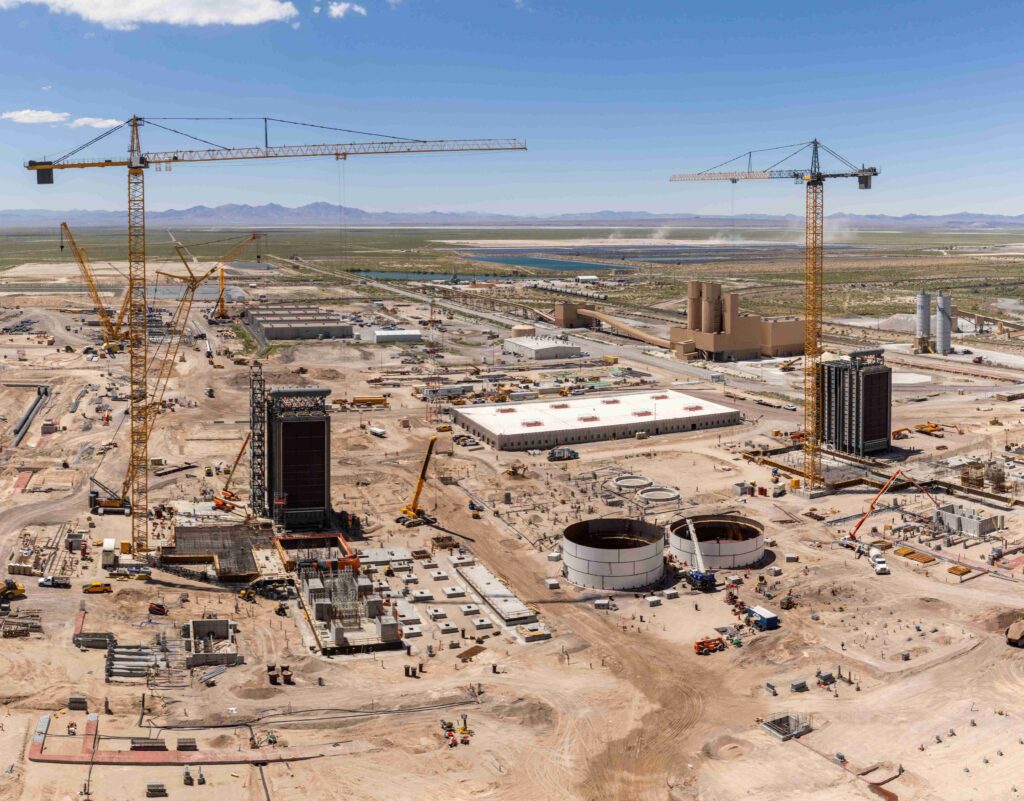J-Class Gas Turbines Arrive at IPP Renewed, Milestone for Giant Utah Cavern Hydrogen Hub Project
Mitsubishi Power has delivered two M501JAC gas turbines to Intermountain Power Project (IPP) Renewed in Delta, Utah, a power plant that will source hydrogen when it begins operation in 2025 from the much-watched giant Advanced Clean Energy Storage (ACES Delta) project.
IPP Renewed’s advanced J-series turbines—each rated at 420 MW (in simple-cycle at ISO conditions)—are slated to replace two 1986–completed coal-fired units at the 1,800-MW IPP in Millard County, which lies in the Great Basin region of western Utah. The two M501JAC turbines will be capable of utilizing a fuel blend of 30% hydrogen by volume when they begin operation in 2025.
However, under a 20-year long-term service agreement (LTSA), Mitsubishi Power will incrementally increase the amount of hydrogen in the fuel mix as available from the adjacent ACES Delta project to achieve a 100% hydrogen combustion volume by 2045, catering to California’s stringent mandate for carbon-free power. Mitsubishi Power has told POWER development continues on a second-generation combustion system that will enable the JAC units to achieve 100% hydrogen fueling by 2045.
The IPP 4,614-acre site is owned by Intermountain Power Agency (IPA), an agency established by Utah state law in 1977 and today comprises 23 Utah electric utility–owning municipalities. IPP Renewed’s project scope, which kicked off in November 2019, also includes the modernization of IPP’s 2.4-GW Southern Transmission System, which provides a direct-current link from the IPP site in Delta, Utah, to Southern California. It will also involve the development of hydrogen production and long-term storage capabilities. Kiewit subsidiary, TIC (The Industrial Company), is the power plant’s engineering, procurement, and construction (EPC) contractor.

Drilling Operation for ACES Delta First Phase Caverns Completed
Mitsubishi Power partnered with Magnum Development in 2019 to kick off the development and construction of the ACES Delta hub. The hub, which is now backed by a $504 million federal loan guarantee, envisions producing up to 100 metric tonnes per day of hydrogen from water and renewable energy sources using a 220-MW alkaline electrolyzer bank manufactured by Norwegian firm HydrogenPro. One of the largest deployments of its type to date, ACES Delta will store that hydrogen in two gigantic solution-mined caverns sited in the only salt dome in the Western U.S, each of which can store up to 150 GWh of energy.
In May, WSP, which is providing EPC management services for the development of the two large salt cavern storage facilities, said it successfully completed drilling operation and mechanical integrity tests for the cavern wells as part of the first phase of the ACES project (ACES 1).
A salt cavern takes roughly two years to construct. “The best way to think about that site is as a big block of salt. What we do is drill into that salt with conventional drilling practices,” Mitsubishi Power explained to POWER last year. “It’s literally just drilling a well down, and then we inject water. Water dissolves salt, and then based on where we put the ‘stringer,’ you basically keep dissolving the salt, bringing that water out, putting new fresh water in.” This “solution mining” process requires large evaporation ponds that contain brine solution but “no exotic materials” other than “time and water.”

WSP confirmed the drilling operation for each cavern well was completed “ahead of schedule, and both cavern wells have successfully passed the mechanical integrity test designated to ensure well integrity prior to the start of the solution mining process.”
Upon completion of the solution mining process, the total cavern volume of 9 million barrels-equivalent “will be able to store around 300 GWh of clean and reliable energy in the form of hydrogen,” WSP said. “These will be the fourth and fifth hydrogen-compatible caverns in the U.S., and the salt cavern storage capacity will make it possible to store excess renewable energy produced in the spring when energy demand is low and use it to generate energy in the summer when demand is high.”
Incremental Progress for a Big Vision
The recent arrival of IPP Renewed’s gas turbines on June 8 and July 21 marked another significant milestone, Mitsubishi Power noted. The 694,000-pound turbines journeyed from Mitsubishi Power’s facility in Takasago, Japan, traveling over 5,800 miles in 30 days in a “complex logistical undertaking,” it said.
Bill Newsom, president and CEO of Mitsubishi Power Americas, highlighted the IPP Renewed’s progress as a “perfect example of a real, steel-on-the-ground project.” It “demonstrates that bringing together the right partners with the right capabilities supports essential renewable energy infrastructures emergence and moves the country further along the path to net-zero emissions,” he added. “The long journey they traveled and final delivery of these two state-of-the-art gas turbines is just the first of many milestones we look forward to celebrating with IPA.”
Mitsubishi Power and ACES partner Magnum note that the renewable energy storage hub—comprising IPP Renewed and ACES Delta—is one of the world’s first projects to combine utility and industrial-scale renewable hydrogen production, storage, and transmission. It is “capable of decarbonizing the western U.S,” ACES Delta suggests. “It would take more than 80,000 shipping containers of lithium-ion batteries to produce the equivalent megawatt-hours of energy that one hydrogen salt cavern can store. Just one of the salt caverns at the Advanced Clean Energy Storage site has the capacity to store the entire state of California’s monthly curtailed energy,” it says.
When completed, ACES Delta envisions the Utah hub could serve as a “model” for other hydrogen hubs and an incubator for other hydrogen innovations. “From this initial project, ACES Delta will deploy hydrogen hubs across the U.S. to accelerate and support the clean energy transition,” the joint venture company adds.
—Sonal Patel is a POWER senior associate editor (@sonalcpatel, @POWERmagazine).